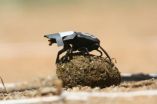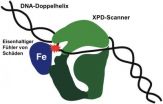(Press-News.org) Magma forms far deeper than geologists previously thought, according to new research results.
A team led by geologist Rajdeep Dasgupta of Rice University put very small samples of peridotite, rock derived from Earth's mantle, under high pressures in a laboratory.
The scientists found that the rock can and does liquify, at least in small amounts, at pressures equivalent to those found as deep as 250 kilometers down in the mantle beneath the ocean floor.
Dasgupta said that this answers several questions about Earth's inner workings.
He is the lead author of a paper that appears today in the journal Nature. The research was funded by the National Science Foundation (NSF).
"The results show that in some parts of the Earth, melting, or magma formation, happens very deep beneath Earth's surface," said geologist Jennifer Wade, a program director in NSF's Division of Earth Sciences, which funded the research.
"It also means that some carbon dioxide and water could come from different sources--and deeper within the Earth--than we believed."
The mantle is the planet's middle layer, a buffer of rock between the crust--the top five miles or so--and the Earth's core.
If one could compress millions of years of observation of the mantle to mere minutes, the mantle would look like a rolling mass of rising and falling material.
This slow but constant churning convection brings materials from deep within the Earth to the surface, and higher, through volcanic eruptions.
The team focused on the mantle beneath the ocean because that's where crust is created and where, Dasgupta said, "the connection between the interior and surface world is established."
Magma rises with convective currents, then cools and spreads out to form ocean-floor crust.
The starting point for melting has long been thought to be at 70 kilometers beneath the seafloor.
That had confounded geologists who had suspected, but could not demonstrate, the existence of deeper magma, said Dasgupta.
For example, when scientists try to determine the mantle's density, they do so by measuring the speed of a seismic wave after an earthquake, from its origin to other points on the planet.
Because such waves travel faster through solids (e.g., crust) than through liquids (e.g., magma), geologists had been surprised to detect waves slowing down, as though passing through liquid, in a zone that should be the mantle's faster "express lane."
"Seismologists have observed anomalies in velocity data as deep as 200 kilometers beneath the ocean floor," Dasgupta said.
"It turns out that trace amounts of magma are generated at this depth, which would potentially explain that" slower velocity.
The research also offers clues to the electrical conductivity of the oceanic mantle.
"The magma at such depths has a high enough concentration of dissolved carbon dioxide that its conductivity is very high," Dasgupta said.
But, because scientists have not yet been able to sample the mantle directly, researchers have had to extrapolate from the properties of rocks carried up to the surface.
So, in a previous study, Dasgupta determined that melting in Earth's deep upper mantle is caused by the presence of carbon dioxide.
The present study shows that carbon helps to make silicate magma at significant depths. And, the researchers also found that carbonated rock melts at significantly lower temperatures than non-carbonated rock.
"This deep melting makes the silicate differentiation [changes in silicate distribution that range from the dense metallic core, to the less-dense silicate-rich mantle, to the thinner crust] of the planet much more efficient than previously thought," Dasgupta said.
"Deep magma is the main agent that brings all the key ingredients for life--water and carbon--to the surface of the Earth."
In Dasgupta's high-pressure lab, volcanic rocks are windows to the planet's interior. The researchers crush tiny rock samples that contain carbon dioxide to find out how deep magma forms.
"We have all the necessary tools to simulate very high pressures--to nearly 750,000 pounds per square inch--and temperatures," he said. "We can subject small amounts of rock to these conditions to see what happens."
The geologists use powerful hydraulic presses to partially melt rocks that contain tiny amounts of carbon, simulating what they believe is happening under equivalent pressures in the mantle.
"When rocks come from deep in the mantle to shallower depths, they cross . . . the solidus [boundary], where rocks begin to undergo partial melting and produce magmas," Dasgupta said.
"Scientists knew the effect of a trace amount of carbon dioxide or water would lower this boundary, but our new estimation made it 150-180 kilometers deeper from the known depth of 70 kilometers," he said.
"What we are now saying is that with just a trace of carbon dioxide in the mantle, melting can begin as deep as around 200 kilometers.
"When we incorporate the effect of trace water, the magma generation depth becomes at least 250 kilometers."
The extent of magma generation is larger than previously thought, he said, and, as a consequence, has the capacity to affect the geophysical and geochemical properties of the entire planet.
INFORMATION:
Co-authors of the paper are Ananya Mallik and Kyusei Tsuno at Rice University; Anthony Withers and Marc Hirschmann at the University of Minnesota; and Greg Hirth at Brown University.
The study was also supported by a Packard Fellowship to Dasgupta.
-NSF-
Magma in Earth's mantle forms deeper than once thought
Study simulating pressures in mantle beneath the ocean floor shows that rocks can melt at depths up to 250 kilometers
2013-01-24
ELSE PRESS RELEASES FROM THIS DATE:
Immigrants: Highly educated, underpaid
2013-01-24
This press release is available in French.
Montreal, January 22, 2013 – The cab driver who was an engineer in his home country, the gas station attendant who used to teach physics, the cashier who trained as a pediatrician. Time and again, new immigrants find themselves in jobs for which their level of education outstrips the requirements, meaning a major loss for the economy.
In a paper recently published in the peer-reviewed open-access journal ISRN Economics, Mesbah Sharaf, an assistant professor in Concordia's Department of Economics, found that two-thirds of recent ...
Pavlov's rats? Rodents trained to link rewards to visual cues
2013-01-24
In experiments on rats outfitted with tiny goggles, scientists say they have learned that the brain's initial vision processing center not only relays visual stimuli, but also can "learn" time intervals and create specifically timed expectations of future rewards. The research, by a team at the Johns Hopkins University School of Medicine and the Massachusetts Institute of Technology, sheds new light on learning and memory-making, the investigators say, and could help explain why people with Alzheimer's disease have trouble remembering recent events.
Results of the study, ...
Smokers who quit before age 40 have lifespan almost as long as people who never smoked
2013-01-24
TORONTO, Jan. 23, 2013—Smokers who quit when they are young adults can live almost as long as people who never smoked, groundbreaking new research has found.
Smoking cuts at least 10 years off a person's lifespan. But a comprehensive analysis of health and death records in the United States found that people who quit smoking before they turn 40 regain almost all of those lost years.
"Quitting smoking before age 40, and preferably well before 40, gives back almost all of the decade of lost life from continued smoking," said Dr. Prabhat Jha, head of the Centre for Global ...
Estrogen fights urinary infection in mouse study
2013-01-24
Estrogen levels drop dramatically in menopause, a time when the risk of urinary tract infections increases significantly.
Researchers at Washington University School of Medicine in St. Louis have found new evidence in mice that the two phenomena are connected by more than just timing. If further research confirms these links, boosting estrogen levels may get a second look as an approach for reducing urinary infections in menopausal women.
"Scientists tested estrogen as a treatment for post-menopausal women with urinary tract infections in the 1990s, but the results ...
Right target, but missing the bulls-eye for Alzheimer's
2013-01-24
Alzheimer's disease is the most common cause of late-life dementia. The disorder is thought to be caused by a protein known as amyloid-beta, or Abeta, which clumps together in the brain, forming plaques that are thought to destroy neurons. This destruction starts early, too, and can presage clinical signs of the disease by up to 20 years.
For decades now, researchers have been trying, with limited success, to develop drugs that prevent this clumping. Such drugs require a "target" — a structure they can bind to, thereby preventing the toxic actions of Abeta.
Now, ...
Discovery of new class of damage-prone DNA regions could lead to better cancer treatments
2013-01-24
Cancer is thought to arise from DNA damage at fragile sites in the genome. A study published by Cell Press on January 24th in the journal Cell reveals a new class of fragile sites that contributes to DNA alterations in a type of blood cancer called B cell lymphoma The findings could lead to the development of more effective treatments for B cell lymphoma and potentially other cancers.
"This study describes an underlying mechanism of genome instability in B cell lymphoma that could not be previously explained," says senior study author André Nussenzweig of the National ...
Dung beetles follow the Milky Way
2013-01-24
You might expect dung beetles to keep their "noses to the ground," but they are actually incredibly attuned to the sky. A report published online on January 24 in Current Biology, a Cell Press publication, shows that even on the darkest of nights, African ball-rolling insects are guided by the soft glow of the Milky Way.
While birds and humans are known to navigate by the stars, the discovery is the first convincing evidence for such abilities in insects, the researchers say. It is also the first known example of any animal getting around by the Milky Way as opposed to ...
Dung beetles use stars for orientation
2013-01-24
An insect with a tiny brain and minimal computing power has become the first animal proven to use the Milky Way for orientation. Scientists from South Africa and Sweden have published findings showing the link between dung beetles and the spray of stars which comprises our galaxy.
Although their eyes are too weak to distinguish individual constellations, dung beetles use the gradient of light to dark provided by the Milky Way to ensure they keep rolling their balls in a straight line and don't circle back to competitors at the dung pile.
"The dung beetles don't care which ...
Discovering the secrets of tumor growth
2013-01-24
Scientists at the University of Copenhagen's Center for Healthy Ageing have identified a compound that blocks the expression of a protein without which certain tumours cannot grow. This compound has the potential as an anticancer agent according to the research published in the journal CHBIOL: Chemistry and Biology this week.
The BLM protein is also known to be important in maintaining stability in cells when they multiply, thus preventing cancer. However, certain types of tumour need BLM to grow. This is typical of osteosarcomas - aggressive malignant tumours often seen ...
A scanner for hereditary defects
2013-01-24
Our DNA is constantly under attack from UV light, toxins and metabolic processes. Proteins and enzymes continually repair the damaged DNA. Unrecognized and therefore unrepaired damage to the genetic material, however, accelerates aging and causes cancer and genetic disorders. A team headed by veterinary pharmacologist and toxicologist Hanspeter Nägeli has now discovered that the protein XPD plays a key role in locating damaged DNA.
XPD protein as scanner
Genetic information is stored on approximately three billion base pairs of adenine/thymine or cytosine/guanine in ...
LAST 30 PRESS RELEASES:
Study finds brain care score can predict risk of stroke across racial groups
Key lung immune cells can intensify allergic reactions
Do hormones explain why women experience more gut pain?
New materials conduct ions in solids as easily as in liquids
Breakthrough of the Year: Renewable energy begins to eclipse fossil fuel-based sources
LLM use is reshaping scientific enterprise by increasing output, reducing quality and more
Introducing LightGen, a chip for ultra-fast, ultra-efficient generative AI
Astronomers see fireworks from violent collisions around nearby star
ACC/AHA issue new guideline on managing congenital heart disease in adults
Cosmic crash caught on camera
Is talented youth nurtured the wrong way? New study shows: top performers develop differently than assumed
Ants: An untapped resource in the development of antibiotics?
Archaeologists use AI to create prehistoric video game
Mitochondria migrate toward the cell membrane in response to high glucose levels
Tiny viral switch offers hope against drug-resistant bacteria
Most parents aware of early peanut introduction guidelines, but confused about details
HPV vaccine can protect against severe lesions of the vulva and vagina
Virtual care provision and emergency department use among children and youth
Quadrivalent HPV vaccine and high-grade vulvovaginal lesions
Insights into dry eyes gained from stem cell-derived tear glands
Researchers identify 166 human pluripotent stem cell lines available for use in clinical applications
Europa Clipper instrument uniquely observed interstellar comet 3I/ATLAS
UN University Report challenges climate change as sole trigger of Syrian Civil War, exposing governance failures in drought response
Real estate investment trust (REIT) acquisition associated with hospital closure and bankruptcy
New Raman imaging system detects subtle tumor signals
Boston Children’s receives a $7.5 million grant from Aligning Research to Impact Autism (ARIA) to provide clinical research coordination for the IMPACT Network
Spray-on antibacterial coating offers new protection for plants against disease and drought
ESMT Berlin study: What makes a first offer successful in negotiations
Groundbreaking ceremony marks the beginning of CTAO-South Array construction in Chile
Why swearing makes you stronger
[Press-News.org] Magma in Earth's mantle forms deeper than once thoughtStudy simulating pressures in mantle beneath the ocean floor shows that rocks can melt at depths up to 250 kilometers






